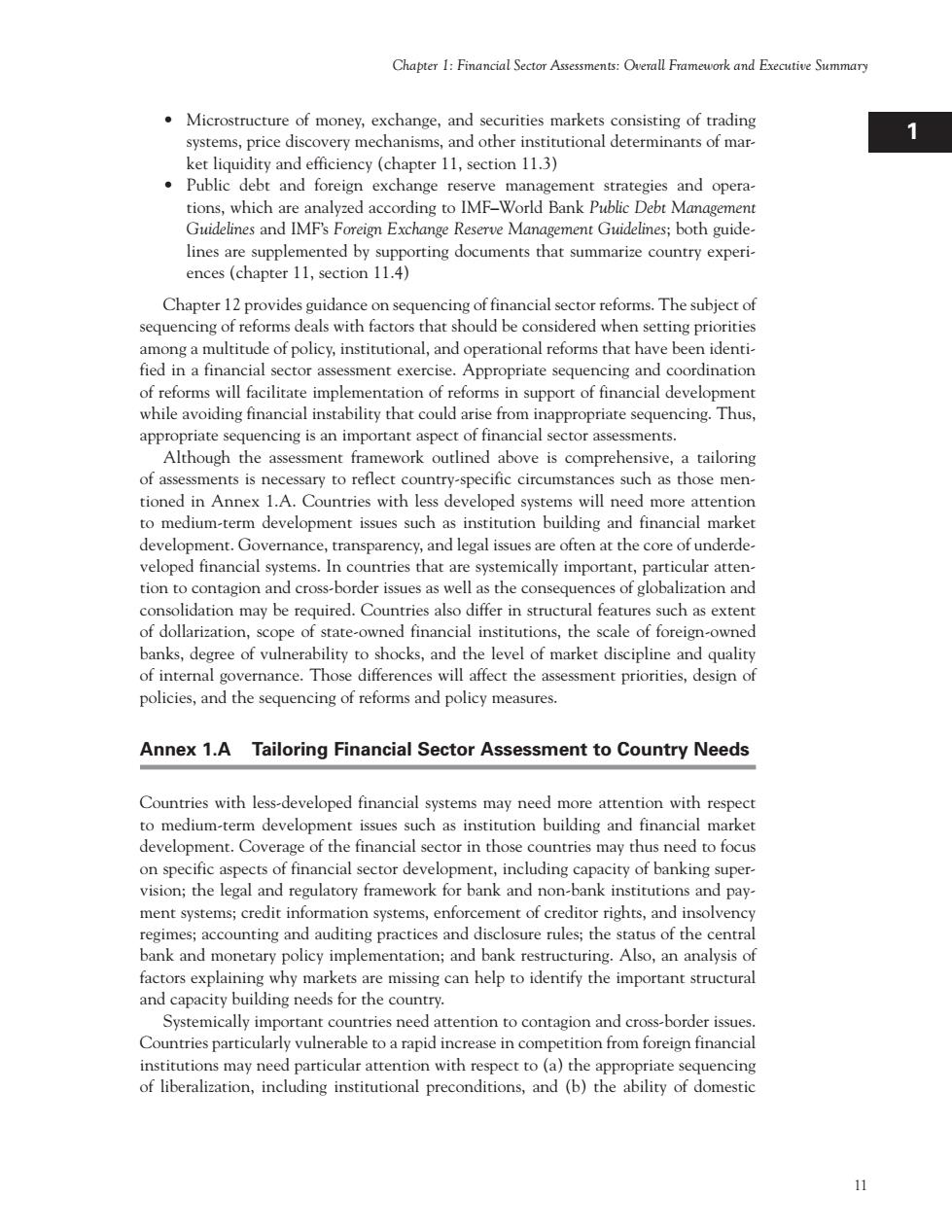正在加载图片...

Chapter 1:Fimancial Sector Assessments:Overall Framework and Executive Summary Microstructure of money and secu rice dis exchange ery mechan rities markers and other terminants of mar 1 liquidiry and efficiency (chapter 1,section 11.3) t and foreign exchange reserve management strategies and opera tions,which are analyzed according to IMF-World Bank Public Debt Management Guidelines and IMF's Foreign Exchange Reserve Management Guidelmes;both guide lines are supplemented by supporting documents that summarize country experi- ences(chapter 11,section 11.4) Chapter 12 provides guidance on sequencing of financial sector reforms.The subiect of sequencing of reforms deals with factors that should be considered when setting priorities among a multitude of policy,institutional,and operational reforms that have been identi fied in a fina sment exercise.Appropriateseq encing and coordinat stabilit y that ou ancial devel te sequ cing.Thu appro enc ing is an important aspect of fn ncial ppropria or ass the assessment framework outlined above is comprehe sment sive,a tailoring of assessments is ne ary to reflect country-specific circumstances such as those men tioned in Annex 1.A.Countries with less developed systems will need more attention to medium-term development issues such as institution building and financial market development.Governance,transparency,and legal issues are often at the core of underde- veloped financial systems.In countries that are systemically important,particular atten- tion to contagion and cross-border issues as well as the consequences of globalization and consolidation may be required.Countries also differ in structural features such as extent of dollarization,scope of state-owned financial institutions,the scale of foreign-owned banks,degre of y erabili to shocks nd the level of m ar vernance T vill affect the ssessment pr policies,and the sequencing of reforms and policy measures Annex 1.A Tailoring Financial Sector Assessment to Country Needs Countries with less-developed financial systems may need more attention with respec to medium-term development issues such as institution building and financial market development.Coverage of the financial sector in those countries may thus need to focus on specific aspects of financial sector development,including capacity of banking super- vision:the legal and regulatory framework for bank and non-bank institutions and pay ment systems:credit information systems,enforcement of creditor rights,and insolvenc regimes;accounting and auditing practices and disclosure rules;the status of the central bank and monetary policy implementation:and bank restructuring.Also,an analysis of factors explai why missin ural and capacity build can help to iden ing needs for e important struct count Systemically ir ortant countries nee attention to contagion and cros -borde Countries particul y vulnera ble to a rapid increase in competition from foreign finan institutions may need particular attention with respect to (a)the appropriate sequencing of liberalization,including institutional preconditions,and (b)the ability of domestic 11 11 Chapter 1: Financial Sector Assessments: Overall Framework and Executive Summary 1 I H G F E D C B A 12 11 10 9 8 7 6 5 4 3 2 • Microstructure of money, exchange, and securities markets consisting of trading systems, price discovery mechanisms, and other institutional determinants of market liquidity and efficiency (chapter 11, section 11.3) • Public debt and foreign exchange reserve management strategies and operations, which are analyzed according to IMF–World Bank Public Debt Management Guidelines and IMF’s Foreign Exchange Reserve Management Guidelines; both guidelines are supplemented by supporting documents that summarize country experiences (chapter 11, section 11.4) Chapter 12 provides guidance on sequencing of financial sector reforms. The subject of sequencing of reforms deals with factors that should be considered when setting priorities among a multitude of policy, institutional, and operational reforms that have been identified in a financial sector assessment exercise. Appropriate sequencing and coordination of reforms will facilitate implementation of reforms in support of financial development while avoiding financial instability that could arise from inappropriate sequencing. Thus, appropriate sequencing is an important aspect of financial sector assessments. Although the assessment framework outlined above is comprehensive, a tailoring of assessments is necessary to reflect country-specific circumstances such as those mentioned in Annex 1.A. Countries with less developed systems will need more attention to medium-term development issues such as institution building and financial market development. Governance, transparency, and legal issues are often at the core of underdeveloped financial systems. In countries that are systemically important, particular attention to contagion and cross-border issues as well as the consequences of globalization and consolidation may be required. Countries also differ in structural features such as extent of dollarization, scope of state-owned financial institutions, the scale of foreign-owned banks, degree of vulnerability to shocks, and the level of market discipline and quality of internal governance. Those differences will affect the assessment priorities, design of policies, and the sequencing of reforms and policy measures. Annex 1.A Tailoring Financial Sector Assessment to Country Needs Countries with less-developed financial systems may need more attention with respect to medium-term development issues such as institution building and financial market development. Coverage of the financial sector in those countries may thus need to focus on specific aspects of financial sector development, including capacity of banking supervision; the legal and regulatory framework for bank and non-bank institutions and payment systems; credit information systems, enforcement of creditor rights, and insolvency regimes; accounting and auditing practices and disclosure rules; the status of the central bank and monetary policy implementation; and bank restructuring. Also, an analysis of factors explaining why markets are missing can help to identify the important structural and capacity building needs for the country. Systemically important countries need attention to contagion and cross-border issues. Countries particularly vulnerable to a rapid increase in competition from foreign financial institutions may need particular attention with respect to (a) the appropriate sequencing of liberalization, including institutional preconditions, and (b) the ability of domestic